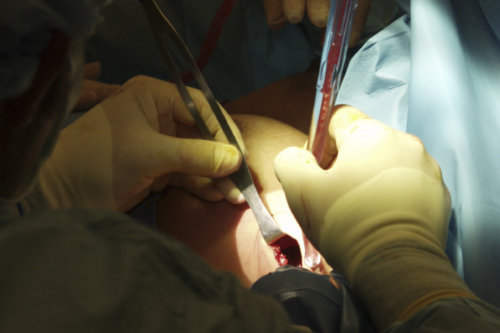
Breast enhancement
Breast enlargement (also called breast augmentation) usually involves putting an artificial implant under the breast tissue, or alternatively under the chest muscle behind the breast..
Breast enlargement - general
You might want to have your breasts enlarged because you feel that they are too small. You could feel that the breasts are too small, possibley after losing weight or following pregnancy. You may want to have a breast enlargement to correct a difference in size between your two breasts.
You may want breast implants if you're having surgery as treatment for breast cancer or other conditions that may have affected the size and shape of your breasts.
Breast implants are made of an outer layer of firm silicone, and are usually filled with silicone gel or salt water. Your surgeon will discuss the size, shape and type of implants that are most suitable for you. during an initial consultation According to the manufacturers of implants they say that they last for at least 10 years, but they may last for longer than this without problems.
 Breast implants
Breast implantsIf you are young and may want to have a family it is likely to still be able to breastfeed with breast implants, and silicone hasn't been found in breast milk.
Breast implants can interfere with mammography so if you are going for breast screening you will need to inform the radiographer or nurse that you have breast implants.
Advice about breast enlargement
It's important not to rush the decision to have cosmetic surgery. Discuss all your options with your GP, who may be able to recommend a surgeon or help you to choose which hospital to be treated in.
It's also important that you discuss the procedure with your surgeon, including what you're hoping to gain from the operation and the result you can realistically expect.
Your operation
The surgeon will explain how to prepare for your operation. For example, if you smoke, you will be asked to stop, as smoking increases your risk of getting a chest and wound infection, which willincrease your recovery time.
The surgery will usually be carried out under a general anaesthetic. This means you will be asleep during the procedure. You will therefore be told to follow fasting instructions. This entails not eating or drinking, usually for around six hours beforehand. Your surgeon will give you more precise advice and it’s important to follow this.
The operation if carried out early enough will mean you should be able to go home on the same day, but depending on certain factors you may need to stay in hospital overnight.
Standard operation procedures will be followed your nurse may check your heart rate and blood pressure, and test your urine.
 Your surgeon may also draw on your breasts to mark the operation site
Your surgeon may also draw on your breasts to mark the operation siteYour surgeon will talk with you what will happen before, during and after your operation, and any pain you might have. This is your opportunity to understand what will happen. It is agood idea to prepare questions to ask about the risks, benefits and any alternatives to the procedure. This will help you to be informed, so you can confidently give your consent for the procedure to go ahead, which you will be asked to do by signing a consent form.
Your surgeon will measure your breasts and assess their shape, your skin and the position of your nipples. Your surgeon may also draw on your breasts to mark the operation site. The surgeon will also photograph your breasts for confidential 'before and after' images. Your surgeon may also want you to have a mammogram taken.
Your nurse will prepare you for your operation. You will be asked to wear compression stockings to prevent blood clots forming in the veins in your legs. You may need to have an injection of an anticlotting medicine called heparin as well as, or instead of, wearing compression stockings.
What happens during breast enlargement
Breast enlargement normally takes between one and two hours. Your surgeon will make cuts in the skin on your breast. The exact position of the cuts can vary from person to person. The cuts are usually in the crease under your breast, around your nipple or towards your armpit, this means any scar will be out of sight after healing.
During the procedure the surgeon will make a space for the implant. The implant usually lies under your breast tissue on top of your chest muscle, but in some cases the impalnt is placed under the chest muscle. This reduces the chance that the edges of the implant will show, and reduce the risk of a complication called capsular contracture, depending on the type of implant your surgeon uses. When placed under the muscles it makes it harder to place larger implants in most cases will mean you have more pain afterwards. Your surgeon will decide which method is best for you.
 During the procedure the surgeon will make a space for the implant
During the procedure the surgeon will make a space for the implantFinally the surgeon will close the cut with stitches (which may be dissolvable), and wrap your breasts in a supportive dressing or support bra.
What to expect afterwards
You will be given painkillers to help relieve any pain as the anaesthetic wears off.
You will need to arrange transport home, also it's advisable to have a friend or relative stay with you for the first 24 hours.
General anaesthesia temporarily affects your co-ordination and reasoning skills, so you must not drive, drink alcohol, operate machinery or sign legal documents for 24 hours afterwards. If you're in any doubt about driving, contact your motor insurer so that you're aware of their recommendations, and always follow your surgeon's advice.
You may go home wearing a support bra, and make sure you follow your surgeon’s advice about when to wear this.
 You may go home wearing a support bra
You may go home wearing a support braThe stitches are removed after about a week. If you have dissolvable stitches, the amount of time they will take to disappear depends on the type of stitches. However, for this procedure, they should usually disappear in about six weeks.
Recovering
If you need them, continue taking painkillers as advised by your surgeon.
At both your initial appointment and before you leave hospital, your surgeon will advise you about returning to your usual activities. You may need around two weeks off work, depending on the operation you have had and what you do at work or home. You shouldn't do any heavy lifting or arm or chest exercise for around a month afterwards. If your surgeon placed your implant under your chest muscle, you may need to reduce your activity for longer.
What are the risks?
As with any operation there are some risks and the same applies to breast enlargement. These are not listed here as they are specific to each individual and differ for every person. Your surgeon will explain how these risks apply to you.
Side-effects.
After surgery, you will have some hardness, discomfort and swelling in your breasts. Bruising and pain may last a few weeks. The scarring will usually fade to pink after around three months, and then fade to white.
Complications
Complications are when problems occur during or after the operation. The possible complications of any operation include an unexpected reaction to the anaesthetic, excessive bleeding or developing a blood clot, usually in a vein in the leg (deep vein thrombosis).
 You may get an infection in your breast
You may get an infection in your breastSpecific complications of breast enlargement include those listed below.
It's common to have a slight difference in size and shape between your breasts, and this can be highlighted by implants.
You may get an infection in your breast. If this happens, your surgeon may need to remove the implant to allow the infection to be properly treated.
Abnormal scar tissue can form around the implant. This can squeeze the implant to make it round and firm. This is called capsular contracture and can be painful. You might need another operation to treat this.
Your breast skin and nipple may feel more or less sensitive after breast enlargement. This usually improves over a few months. If you lose sensation after breast enlargement, it may be permanent.
Sometimes scars can become red, thick and painful and may need more surgery.
Implants can sometimes affect the skin on your breast and you may find your skin has ripples and creases. This most commonly happens in very thin people or after sudden weight loss.
Implants can leak. This may be a slow seeping or a sudden split. If this happens, your implant may need to be removed.
Tagged in Cosmetic Surgery

